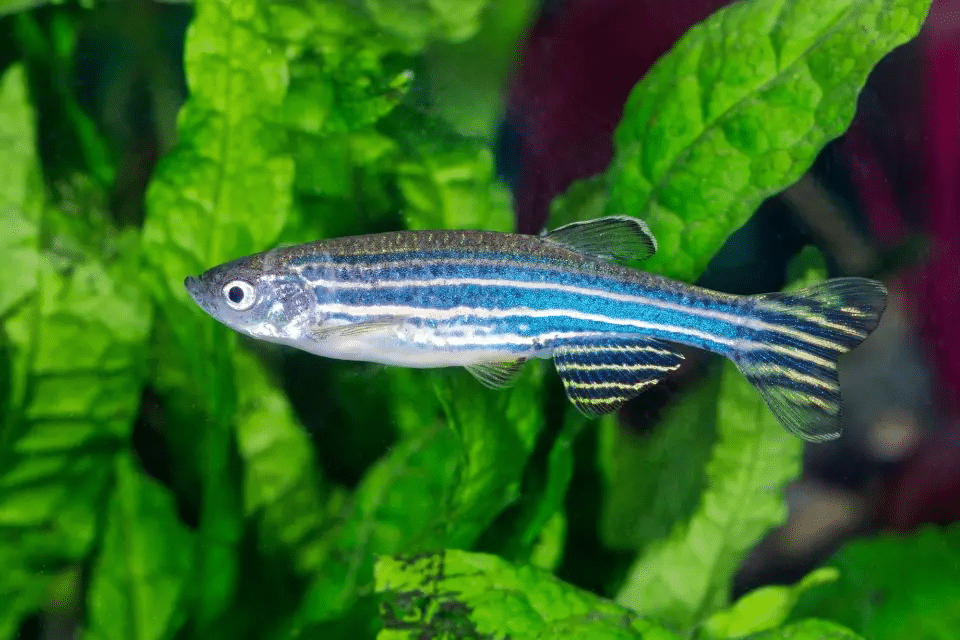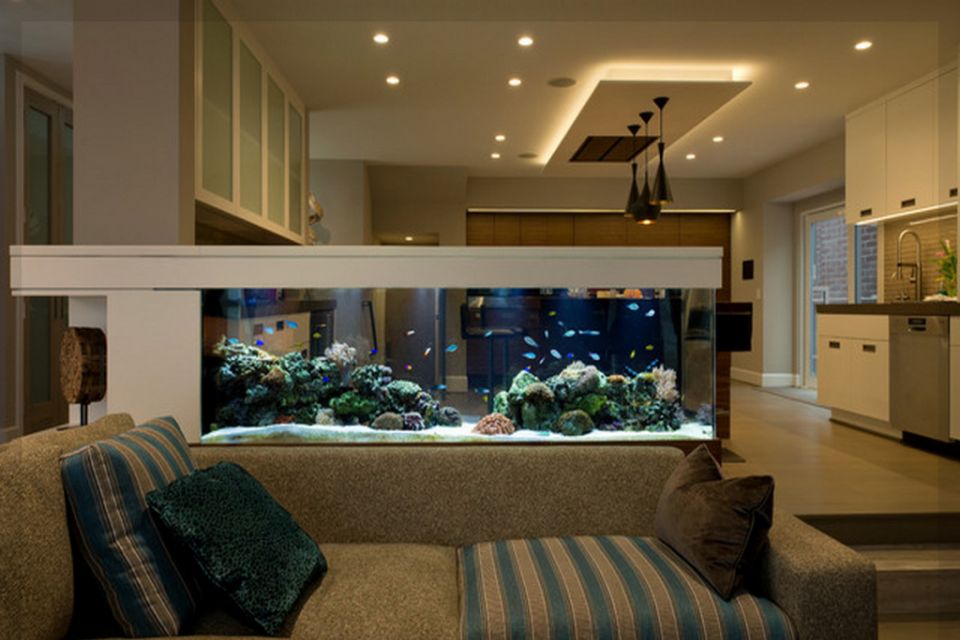
Even though the zebra danio is considered easy to keep, there are some things to consider to give it the best possible quality of life in an aquarium. Everything about keeping, the optimal size of the aquarium, breeding and the necessary water quality for a striped bear can be found in the following aquaristic guide article.
Table of Contents
Everything important about the zebra danio in a nutshell:
- Danio rerio is an ornamental fish that is considered to be easy to keep and is therefore ideal for beginners.
- The zebrafish should be kept in a group with at least 8-10 conspecifics.
- The values of the water should be based on the water values of his homeland. The water temperature should be between 20 and 26°C, the pH value between six and eight and the total hardness between 5° and 20° dH.
- Striped bearcats grow to five to six centimetres, with the females being larger and plump than the males.
- The zebrafish (Danio Rerio) can reach an age of five to six years.
- In his home country he likes small streams or canals, ponds with slowly flowing or standing water, such as ditches, ponds or rice fields.
- The brownish coloration of the back line of the zebrafish becomes a whitish yellow on the flanks and belly, partly with a silvery shimmer.
- The zebra danio is an omnivore and can be fed with small live, dry and frozen food, as well as vegetable food.
- Like most schooling fish, striped danio fish need sufficient space to swim, and a weak current and dense edge planting should not be missing.
- The striped bear is an excellent jumper, therefore its aquarium should be completely covered
- Thanks to its peaceful nature it can be socialized with other fishes.
- A breeding tank should be used for breeding, from which the parent animals are removed after spawning, as they are spawning predators.

Where do zebrafish occur?
The Danio rerio comes originally from Asia. The animals can be found in the wild in the Ganges and in Bangladesh, northern India, Pakistan and southern Nepal. There, they can be found mainly in slowly flowing or stagnant waters, as well as in the rice fields.
How many zebrafish keep in the aquarium?
The striped bear is a schooling fish and loves to swim through the pool with its conspecifics. For this it needs sufficient space. The group should also include at least eight animals. If the keeping of zebrafish in the aquarium is intended, the animals should have at least one tank with a side length of one meter.

How do you keep zebrafish in an aquarium?
As already described in the upper section, the aquarium should definitely have an edge length of one meter. A 180 litre aquarium in the standard dimensions 100x40x40 cm is therefore ideal for keeping zebrafish. The Danio rerio is a quite lively little fish that likes to swim around with its conspecifics in the tank, for this it needs sufficient swimming space.
Like other swimming-joyful swarm-fish, also the zebra-bearling makes big demands on the optimal basin-structure. It is important to find a good balance between hiding places in the form of roots, stones and dense border planting and a swimming area that is as large as possible.

This works wonderfully, with finely feathered plants surrounding the basin and bogwood roots on the ground providing a retreat. The roots should be chosen in such a way that they do not protrude too far into the swimming area of the Striped Bearblings.
Since zebrafish like to take up their food from the water surface, there should be no floating plants. The fish also like to accept a light current in their swimming area, which they can swim towards.
The aquarium should absolutely be completely covered, because zebra danio bears are good jumpers. The animals are lively, but thanks to their peaceful nature they can be socialized well with other fish. More about this in the section “Socialization of Zebrafish”.

Which water values does a zebrafish prefer?
In order to ensure that the zebrafish lead themselves well, the aquarium water should be as close as possible to the original habitat of the animals. In the best case the following water values should be achieved:
- 20°C – 26° C Water temperature
- pH value: 6,0 to 8,0
- Total hardness: 5° to 20° dH
With a temperature of 20-26°C, striped danio feel comfortable in a temperature range that suits many typical South American and Asian ornamental fish. Also the optimal pH-value and the total hardness take on values that many species can become friends with. This underlines once again how well the animals can be socialized with other species – if you go by the water values, the variety of possible stocking combinations is almost unlimited.

Association of Danio rerio
The Zerbafish is a rather hectic small ornamental fish, which is mainly found in the upper part of the tank. Especially in smaller basins, no other species should be socialized with the animals that also live in this region. In a 180 liter aquarium you could very well socialize Zebrafish with South American Dwarf Cichlids, such asRam Cichlids or Cockatoo Dwarf Cichlids, in the middle basin region and with Corydoras or Otoclintus in the lower basin region.
Otherwise, other barbels are an ideal match for the Danio rerio, as they come from the same home and have quite similar demands on water quality.

Nevertheless, the preferred water parameters of the animals and the peaceful species make friends with countless other species, which is why the animals could in principle be socialized with characins, small cichlids, gourami, invertebrates or even some livebearers.
Crabs should not be socialized with the zebrafish, as there is a high risk of injury for the little bearblings.

What does a zebra danio eat?
In the wild, the Danio rerio eats mainly insect larvae, small crustaceans and worms. Since the zebra danio is an omnivore, it is happy to have small living, dry and frozen food in the aquarium, as well as plant food – it has sometimes been reported that the animals even eat algae in the aquarium. By the way, we have explained all the differences between the common types of aquarium fish food in our guide article.
A varied diet keeps the little fish healthy. The administration of vegetable food prevents the zebrafish from nibbling on the plants in the aquarium. Instead of a large feeding daily, the animals are also often fed several times in smaller portions. This can be realized very well with an automatic aquarium feeder. However, this should also depend on the rest of the stock in the aquarium, the animals tend to eat their food away from their fellow inhabitants. Especially if the animals are socialized with ground-near species you should make sure that enough food reaches the ground – in some cases it may be advisable to give food tablets every two days, which will sink into the aquarium.

How are zebrafish bred?
The zebra danio is a free spawner. In the wild, the spawning season of the Danio rerio is at the beginning of the monsoon, i.e. the rainy season, so high-quality live food and a slight change in water temperature can increase the willingness to spawn.
The breeding is started by feeding the parents exclusively with mosquito larvae for one week, furthermore the water should not be changed during this week. Then you prepare a small breeding tank which is filled with at least five litres of water – bigger is always possible. The water should stand for two days. Then the tank is filled with fine plants. The plants should be weighted down with a stone so that they sink to the ground. An air-operated sponge filter is added. To keep the temperature constant at 24°C to 25°C, a heating rod should be used. The pool can be placed on a windowsill to get morning sun, but this is not absolutely necessary. Since the parents are spawn robbers, spawning rust should be introduced.

In the afternoon the parents are again fed with plenty of mosquito larvae. Then the Danio rerio pair can be transferred to the breeding tank. If you have a larger spawning tank, two to three females and three to five males can be put together to further increase the breeding chances.
If everything has worked out so far, the zebrafish catch the animals use a plant tuft for spawning after mating. The eggs fall to the ground, as they do not stick to the ground. They are about one millimetre in size and almost invisible. If you shine a flashlight at an angle in the dark, you should be able to see the eggs.

The next day, the adult fishermen are put back into the normal tank, the filter and heating rod are removed from the breeding tank and the water is stirred. The eggs fall to the bottom due to the turbulence, while the dirt and excrement floats around. This can now be sucked off carefully with a fine hose. Then fill up the water in the breeding tank again, put the filter and the heater back and darken the tank well.
At a water temperature of 25°C you can see the eyes of the fish in the eggs after about one day and after about two days the young animals finally hatch. A few days later the young fish can already swim freely. As soon as the young swim freely, they should be fed with dust-fine flakes.
It is best to breed in a larger breeding tank, as this is easier to clean without endangering the young animals. In addition, the offspring need sufficient space to grow evenly. Otherwise the young animals grow very fast and can be placed with their parents after a few weeks.
If this is too much trouble for you, you can also force the breeding in the community tank by creating the same conditions as mentioned above and laying out java moss. So the young animals have a hiding place and with a little luck some of the animals can survive. You can increase the chance considerably by providing the internal filter with a nylon stocking so that the small animals are not sucked in in rows.
Conclusion: Keeping zebrafish in an aquarium is uncomplicated.
The Asian zebra danio is easy to keep even for beginners in aquaristics. As long as the water is warm enough, has the right pH value and the right hardness, it is quite undemanding.
The pool should have an edge length of one meter and should have a combination of hiding places and sufficient swimming space.
Zebrafish are omnivores and enjoy a varied diet: whether vegetable, live or dry food, the animals are also relatively undemanding when it comes to eating.
The peaceful bearling can be easily socialized with other species that have the same demands on the quality of the water, and it is best to inhabit predominantly other areas of the pool.
The rearing is as uncomplicated as the keeping of the animals. You only have to consider that the parents are spawn robbers and do not have any consideration for their own offspring. In addition, the breeding season should be heralded by feeding live food and a breeding tank should be provided for the parents.



